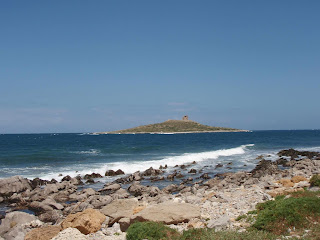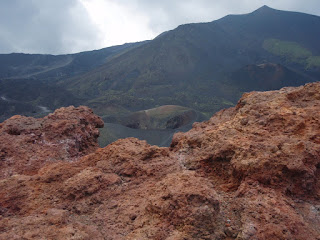There had
been reports of a fire at the Zingaro natural park, close to our previous stop
at Capo St Vito, which got us talking about the hay harvest, currently in full
swing here, where it seems common practice to burn the remaining stubble.
With Sicily's high winds and arid climate we're curious to know why it's done
this way, and wondered if any secondary fires are caused by it. We passed
one blaze right by the roadside which was clearly out of control and saw the
remnants of many others, small patches of charred landscape, especially on our
drive around the south and west coasts.
Sicily seems to be intensively cultivated and proud of its produce, including local wines and citrus fruit, although the latter has taken a back seat to more profitable crops in recent years. There is very much a sense of independence on the island and a local we chatted to today described his origins to us as Sicilian 'DOC' (like DOC wines!) and our return to the mainland was referred to as 'going back to Italy' by a campsite owner.
Sicily seems to be intensively cultivated and proud of its produce, including local wines and citrus fruit, although the latter has taken a back seat to more profitable crops in recent years. There is very much a sense of independence on the island and a local we chatted to today described his origins to us as Sicilian 'DOC' (like DOC wines!) and our return to the mainland was referred to as 'going back to Italy' by a campsite owner.
As we've
probably said before, the scenery all over Sicily is pretty amazing, and after
another breathtaking drive we arrived at camping La Playa at Isola delle
Femmine in time to join the 4:30pm queue! Lots of campervanners use this site
as a stopover for visiting Palermo and jolly convenient it is too, as well as
being very boundaried about its siesta times; the site closes its gates, and
doors, for three hours at lunchtime!
After a super
helpful Palermo visit briefing by Daniela at the campsite (she provides group
briefings to all new arrivals in fluent French, English and German - every
evening if needed; very impressive!) we retired early in preparation for a day
in Sicily's capital. It's an easy journey, just 30 minutes on the train and we
got off 2 stops early on Daniela's suggestion, at Orleans Station, opposite the
Palazzo Reale. As I was keen to get along to the morning foodmarkets, we
put that on hold and headed straight off via a small church, San Giovanni degli
Ermiti and garden. Then off through the city . . .
We arrived
soon after to Ballaro market, an explosion of colour and noise. The
market is open air and in a network of mainly pedestrianised streets, give or
take the odd 3 wheeler! The produce here is fantastic - and I have to wax
lyrical here, Jamie Oliver style!! Stall after stall of amazing fruit and
veg, along with specialist vendors selling cheeses, herbs, olives and fish, specialising
in pesce spada (swordfish) cut straight from the beast itself, the heads
displayed on the counters. There were sardines too, and gilthead bream,
in fact the most fish we've seen since arriving in Italy. I could have
come away laden, but we had a day of sightseeing ahead, so we decided to stuff
our faces at a restaurant in the market instead, but not before buying a kilo
of fresh figs from Messina, and some herbs and olives.
Lunch was
delicious, and what a fascinating spot to people watch, sat outdoors at the
entrance to the market. We ate a mixed starter platter with sardines,
octopus, peppers and aubergine, followed by an enormous pesce spada steak (me)
and a mixed fish platter (Mr B).
Then off to
wander the streets and absorb the atmosphere of this vibrant city. We
stopped at one more recommended church, Martorana, which was beautiful, with
sumptuous Greek style mosaics in golds and blues; a real wow moment on
entry! The racy Florentine style fountain nearby was pretty impressive
too, although I'm still sulking a bit about the Trevi!
Then it was
time to head back. There's a lot more to see here than we'd want to do in
a day, and we heard that Monreale, a short bus ride away is worth a visit too -
maybe another time.
Back at La
Playa, we decided to stay on for a day to rest. Four consecutive days
sightseeing in the heat is pretty tiring! Next day we wandered along the
peninsula to the village of Isola delle Femmine to see the old tower and
harbour and to buy some fresh pesce spada from a hole in the wall fishmonger,
and fruit and veg from a greengrocers, much nicer than the supermarket and a
mini language lesson too. At the fish stall we learned that pica (not
poco) is Sicilian for a little, and at the greengrocers that finochio (fennel,
which we were buying) is slang for gay - a bit of a random conversation that
one! We also sampled salted sardines from huge tins, which were being sold
loose; they're a bit like anchovies in texture and taste, and bought some of
the juiciest tomatoes I've ever eaten. The tomatoes here are wonderful
and come in all shapes and sizes, each more delicious than the last, probably
with summer hotting up, which it certainly is!
The coast at Isola delle Femmine
Then it was
time for another early night and attempt number three at sleeping through the
local disco and karaoke before setting off for our next stop, just east of
Cefalu.
We arrived at
Rais Gerbi camping, near Finale, with some trepidation; it's a 250 pitch
holiday village and the last one described like that we'd bailed out of after
one night! This one however, was a nice surprise and we managed to
bag a fabulous pitch overlooking the saltwater pool, which itself overlooked
the beach with the Aeolian islands shimmering on the horizon. We stayed
five nights, swimming, sunbathing and getting very hot. Temperatures are
rocketing! If you look closely you might be able to see my nifty swimhat in the pic below, compulsory poolwear at this site!
We celebrated
our final night with a delicious pizza from the restaurant and home made salad,
eaten on our pitch with a view, and then it was time to head to our final stop
on the island, a campsite on the Marinello Lagoons near the ancient city of
Tyndaris.
J.
























































